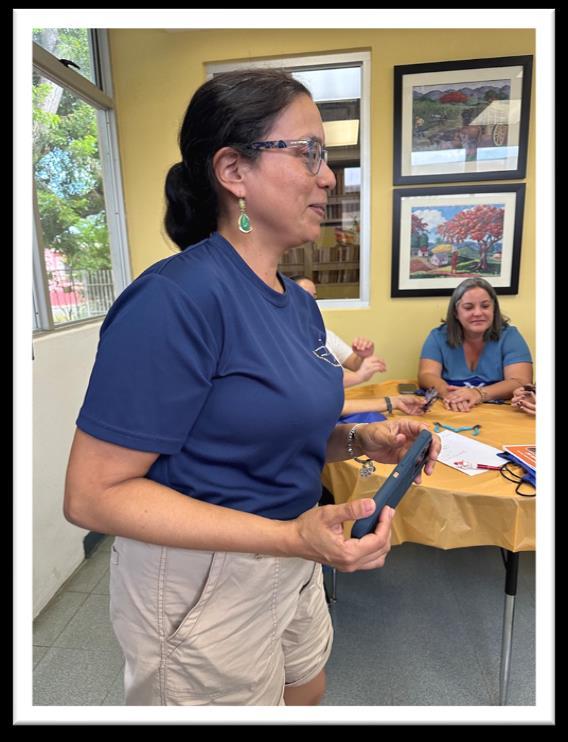Is that fish edible?
CONTINUING EDUCATION COURSE FOR CHEFS ON UNDERUTILIZED FISH AND WORKSHOP TO MAKE JEWELRY WITH LIONFISH SPINES
Jannette Ramos García
Outreach and Education Member Panel
Is that fish edible?
As part of the campaign on underutilized species conducted by the Outreach and Education Panel of the Caribbean Fishery Management Council on July 8 and 9, 2024, a continuing education course for chefs was held.
The course was offered at the DeRaíz restaurant in the municipality of Mayagüez.
18 chefs attended from all over the Island, including from renowned restaurants.
One day before…
On Sunday before the course, Cristina and I visitedVanessa Ramírez (Vice Chair at the CFMC) to collect underutilized fish to prepare the broth that the chefs would use on the designated day to cook the different species.
The course was divided into two days, each with different educational activities.
DAY ONE
THE INSTRUCTORS
Nelson Crespo: Deep-sea snapper fisherman and President of the District Advisory Panel
His participation provided his insight and how he engages in conservation practices for commercially valuable species.
Nelson introduced six underutilized species and provided information on their habitats, meat quality, fishing depths, among other details.
Chef Carlos Portela: James Beard Award Finalist and Orujo Taller de Gastronomía Owner and Chef
Presented ways to identify fresh fish, including cuts and proper storage to prevent spoilage.
Discussed the recommended cooking temperatures for various types of fish.
As a chef, emphasized the importance of educating consumers about lesser-known fish species.
Explained how to add value to each fish portion and the potential yield from each fish.
Acknowledged that regardless of the fish size, it can be utilized effectively.
Taught students that every part of the fish can be used for consumption, among other topics.
Cristina D. Olán Martínez Social Media Network Coordinator at the CFMC
Although Cristina did not participate as an instructor, she provided valuable information during every talk and contributed by documenting all the processes over both days.
Jannette Ramos García – Outreach and Education Member Panel
Marine extensionist at Puerto Rico Sea Grant Program
In my case, I highlighted the need to diversify fishing catches to preserve the more heavily fished species.
I discussed the factors that affect fishing in Puerto Rico.
Another topic was how we can promote the fishing and consumption of underutilized species and the reasons for doing so.
At the end of the first workday,we received the fish to be used in the course. It was supplied by Tommy Forte, a dealer who runs a fishery in the municipality of Cataño.Tommy has been a great collaborator in all our culinary activities requiring fresh fish of all kinds for the CFMC, the Come Pez León Festival, and others.
DAY TWO
On the second day, the chefs entered the kitchen to work with the species presented the day before.They were visually identified again for the benefit of the chefs.
It was wonderful to see the creativity of these chefs. Absolutely nothing from the fish was wasted. Every part was used to create delicious dishes
SIX OF THE CHEFS WERE WOMEN.
ONE OF THEM CAME FROM LALA’S, BAD BUNNY’S RESTAURANT.
Following the course, I have received calls from several chefs informing me that they have incorporated some of these species into their creations.
After the course, several documents were sent with additional information, including a list of fishermen, fish markets, and suppliers who sell the presented species, so they have access to this information.
WORKSHOP ON CREATING JEWELRY WITH LIONFISH SPINE
This workshop was created with several purposes:
1. To continue educating about the threat this species possess to other commercially and ornamentally important species in our seas.
2. To demonstrate that lionfish spines also represent an opportunity to create products such as jewelry.
3. To teach a creative way to generate income with minimal effort, where creativity is the most important factor. In this phase, financial collaboration occurs with fishermen who capture lionfish and with small vendors who sell the tools needed to work on the jewelry.
On this occasion, I had the responsibility of opening the workshop with an educational presentation about the lionfish.
But the highlight of the afternoon was the artisan Glory Albino, or Lola Irie, as she prefers to be called. She spoke about how to prepare the spines for use in jewelry making. She distributed the materials and guided each of the 12 women who attended from various parts of the island, giving them the opportunity to bring their ideas to life.
We also had the presence of our colleague Cristina D. Olán Martínez, who through her work ensures that our efforts are seen by our audience across all social media platforms.
















































